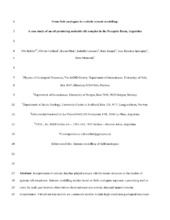From field analogues to realistic seismic modelling: a case study of an oil-producing andesitic sill complex in the Neuquén Basin, Argentina
Rabbel, Ole; Galland, Olivier; Mair, Karen; Lecomte, Isabelle; Senger, Kim; Spacapan, Juan Bautista; Manceda, Rene
Peer reviewed, Journal article
Accepted version
Permanent lenke
https://hdl.handle.net/1956/20672Utgivelsesdato
2018Metadata
Vis full innførselSamlinger
- Department of Earth Science [1050]
Originalversjon
https://doi.org/10.1144/jgs2017-116Sammendrag
Interpretation of seismic data has played a major role in recent advances in the studies of igneous sill complexes. Seismic modelling studies based on field analogues represent a promising tool to close the scale gap between observations from outcrops and seismic data and support seismic interpretation. Virtual outcrop models are commonly used to include highresolution geological structures in models of seismic-scale field analogues. However, realistic seismic modelling requires not only detailed structural input, but also well-constrained elastic properties and an adequate seismic modelling technique. Here, we present a seismic modelling study of oil-producing andesitic sills in the Neuquén Basin, Argentina, which implements all modelling elements at high accuracy by combining virtual outcrop models, well data and a 2(3)D filtering method. Our results indicate that the modelled seismic signatures of intrusive bodies observed in field analogues are characterized by frequencydependent interference and strong amplitude variations owing to highly variable elastic properties of both host rock and sills. We demonstrate that detailed waveform patterns observed in real seismic data can be linked to intrusive bodies below the traditionally assumed limit of resolution via realistic seismic modelling. This illustrates how an integrated modelling approach based on field analogues can aid seismic interpretation.
